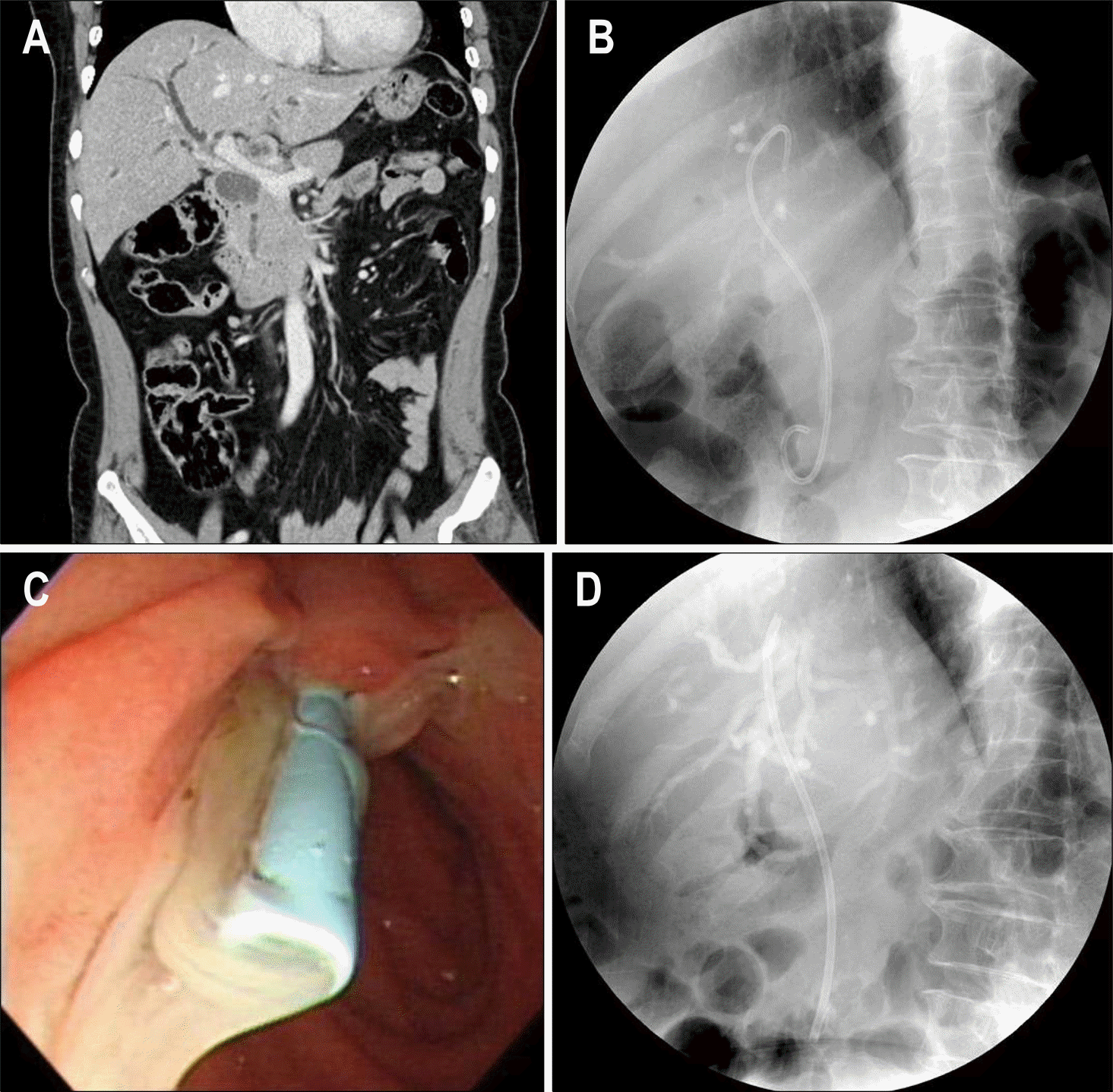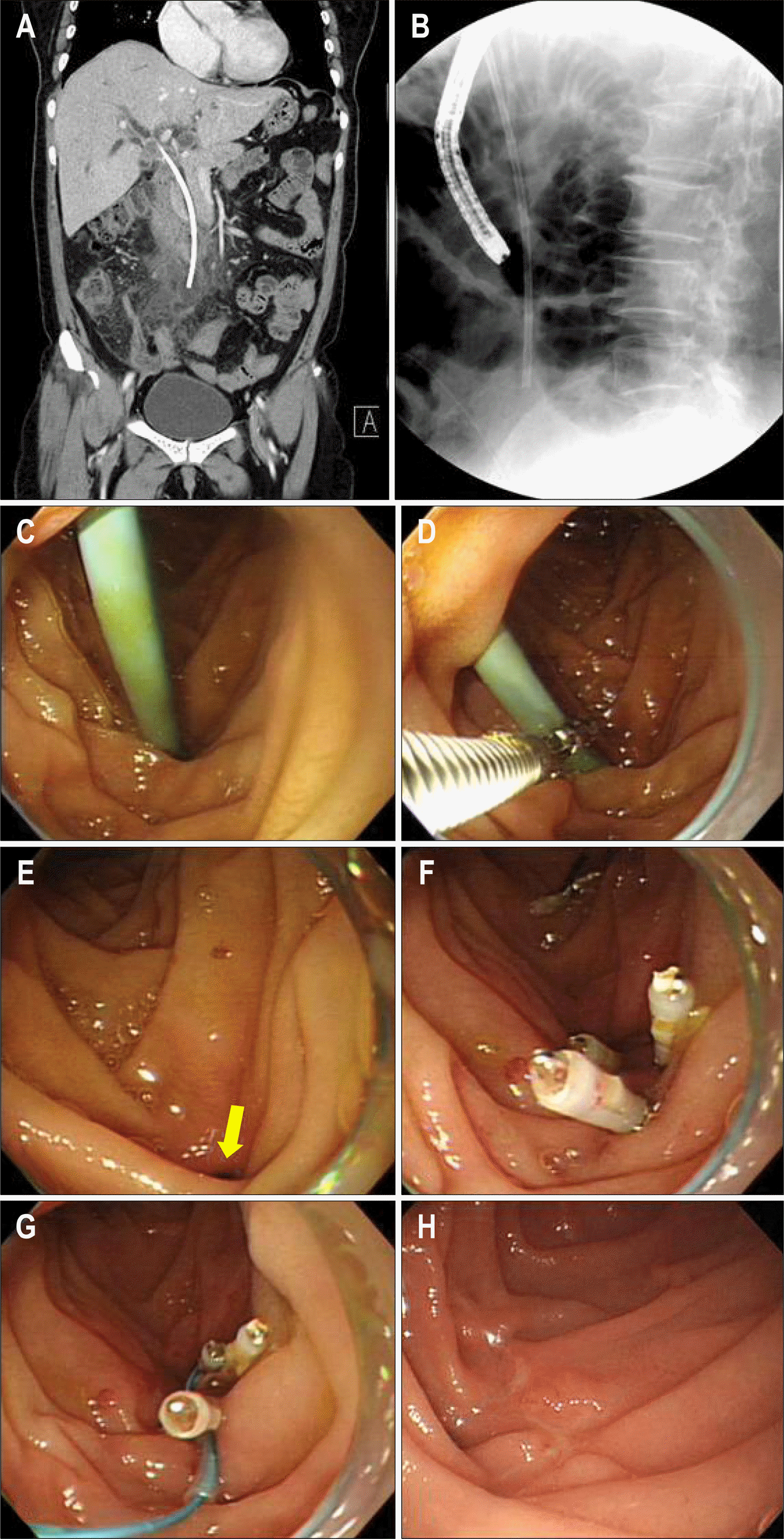Abstract
Endoscopic retrograde biliary drainage (ERBD) is useful for the palliative decompression of biliary obstruction. However, the complications of ERBD include cholangitis, hemorrhage, acute pancreatitis, obstruction of the stent, and duodenal perforation. Pressure necrosis on the duodenal mucosa by the stent may contribute to perforation. Although duodenal perforation following ERBD is very rare compared to other complications, it can result in a fatal outcome. Recent reports describe nonsurgical treatment for small gastrointestinal perforation with localized peritonitis and suggest that endoclipping may be appropriate in the management of a well selected group of patients with iatrogenic perforation. We describe a case of duodenal perforation secondary to ERBD that was successfully treated with approximating using endoclip and detachable snare.
Go to : 
References
1. Shim CS, Kim JH, Cho SW. Clinical study of endoscopic retrograde biliary drainage (ERBD) in malignant obstructive jaundice. Korean J Med. 1988; 35:644–651.
2. Aliperti G. Complications related to diagnostic and therapeutic endoscopic retrograde cholangiopancreatography. Gastrointest Endosc Clin N Am. 1996; 6:379–407.

3. Trap R, Adamsen S, Hart-Hansen O, Henriksen M. Severe and fatal complications after diagnostic and therapeutic ERCP: a prospective series of claims to insurance covering public hospitals. Endoscopy. 1999; 31:125–130.

4. Gould J, Train JS, Dan SJ, Mitty HA. Duodenal perforation as a delayed complication of placement of a biliary endoprosthesis. Radiology. 1988; 167:467–469.

5. Cotton PB, Lehman G, Vennens J, et al. Endoscopic sphincterotomy complications and their management: an attempt at consensus. Gastrointest Endosc. 1991; 37:383–393.

6. Lee DK. Perforation and others. Korean J Gastrointest Endosc. 2003; 27:321–325.
7. Lammer J, Neumayer K. Biliary drainage endoprostheses: experience with 201 placements. Radiology. 1986; 159:625–629.

8. Rosés LL, Ramirez AG, Seco AL, et al. Clip closure of a duodenal perforation secondary to a biliary stent. Gastrointest Endosc. 2000; 51:487–489.

9. Soehendra N, Reynders-Frederix V. Palliative biliary duct drainage. A new method for endoscopic introduction of a new drain. Dtsch Med Wochenschr. 1979; 104:206–207.
10. You YK, Moon JH, Lee MS, et al. A case of duodenal perforation following endoscopic biliary drainage (EBD). Korean J Gastrointest Endosc. 1992; 12:91–97.
11. Avgerinos DV, Llaguna OH, Lo AY, Voli J, Leitman IM. Management of endoscopic retrograde cholangiopancreatography: related duodenal perforations. Surg Endosc. 2009; 23:833–838.

12. Miller G, Yim D, Macari M, Harris M, Shamamian P. Retroperitoneal perforation of the duodenum from biliary stent erosion. Curr Surg. 2005; 62:512–515.

13. Binmoeller KF, Grimm H, Soehendra N. Endoscopic closure of a perforation using metallic clips after snare excision of a gastric leiomyoma. Gastrointest Endosc. 1993; 39:172–174.

14. Baron TH, Gostout CJ, Herman L. Hemoclip repair of a sphincterotomy-induced duodenal perforation. Gastrointest Endosc. 2000; 52:566–568.

15. Kaneko T, Akamatsu T, Shimodaira K, et al. Nonsurgical treatment of duodenal perforation by endoscopic repair using a clipping device. Gastrointest Endosc. 1999; 50:410–413.

16. Pontecorvo C, Pesce G. The ‘safety snare’–a ligature-placing snare to prevent haemorrhage after transection of large pedunculated polyps. Endoscopy. 1986; 18:55–56.
17. Hachisu T. A new detachable snare for hemostasis in the removal of large polyps or other elevated lesions. Surg Endosc. 1991; 5:70–74.

18. Lee DW, An SG, Lee SM, et al. A case of gastric perforation due to endoscopic mucosal resection managed by detachable snare and hemoclips. Korean J Gastrointest Endosc. 2005; 30:199–203.
Go to : 
 | Fig. 1.(A) CT finding. Contrast-enhanced coronal reformatted CT image showed abrupt narrowing of the extrahepatic bile duct caused by the invasion of gallbladder cancer. (B) ERCP finding. A 7 Fr pigtail catheter was inserted into the left intrahepatic duct. (C) Duodenoscopic finding. Pus-like materials were drained after 10 Fr plastic stent insertion. (D) ERCP finding. A 10 Fr plastic stent was inserted into the left intrahepatic duct. |
 | Fig. 2.(A) CT finding. Contrast-en-hanced coronal reformatted CT image showed duodenal perforation caused by the plastic biliary stent and soft tissue strandings around the duodenum. (B) ERCP finding. The distal end of the straight plastic stent penetrated the duodenal wall. (C-H) Duodenoscopic findings. (C) A 10 Fr straight plastic stent penetrated the duodenal wall at the opposite side of ampulla. (D) A plastic stent was removed using a stent forcep. (E) Perforated hole in the duodenum (arrow) was confirmed after the removal of plastic stent. (F) Perforated hole was closed using the three hemoclips. (G) Three clips were used as buttress to perform additional approximation using detachable snare. (H) After 2 weeks of procedure, the previous perforated site was completely healed. |




 PDF
PDF ePub
ePub Citation
Citation Print
Print


 XML Download
XML Download